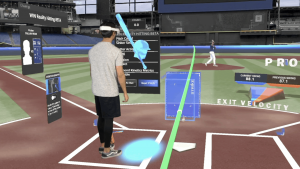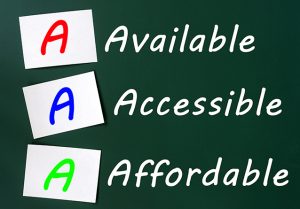AR & VR – Week 12
After tonight’s presentation I feel confident that my knowledge of AR and VR has improved, but I still feel this realm of technology far exceeds my technological understandings. To better understand how VR could be used in the classroom I started by watching the math lesson video.
First off, math is overtly boring, and I avoid it at all costs. My best friend is a math teacher and I make fun of her all the time because to her math is “amazing and exciting”. Watching the lesson, I cared less about what actual math was happening and whether the pigeon was going to come back, or someone was going to come up behind the teacher and take him out. The surroundings felt like a violent video game and I was waiting for something bad to happen. I do not play video games at all, not one. I think I played one “round” of Fortnite in my entire life. I understand that for students who are passionate about video games this setting might really work for them, but for me, it felt inauthentic, like a teacher was checking the box “taught math with VR”.
As a Phys. Ed. teacher, I know VR would be successful in my classroom/gym. My husband is the manager of a baseball training facility in Regina and they use VR in their weekly programs. The facility owns one or two Oculus headsets where they use the program Win Reality for baseball related training.

https://winreality.com/blog/win-u-episode-6-hitting-beta-2/
When Chris first purchased the Oculus, I had an opportunity to try it out. The program offers several smaller games to help with the various baseball-related skills. The first game I tried required me to stand at the plate and identify the type of pitch the pitcher was throwing. I had to identify if the pitch was a fastball, curveball, slider, sinker, or change-up. The second game I tried simulated different types of pitches and speeds. I used the controllers to swing at the pitches and was given feedback on how my swing would have made contact with the ball. You can now get an attachment for bats to provide even more accurate swing feedback. This technology would be successful with a lot of different sports/games and I think it would benefit students with various disabilities, students who are injured and cannot fully participate, students who do not overly enjoy physical activity, and students who love technology and video games. Given the fact that I typically have anywhere from 30-40 students in my Phys. Ed. classes I do not think a single Oculus or even a couple would benefit my classroom. Typically, students are wound up (my grade 9’s) and I can see them fighting over who gets to use it and being incredibly rough with the headset and controllers.

https://www.careereducationreview.net/2019/07/inclusive-access-is-it-the-answer-to-course-materials-accessibility-and-affordability-challenges/
I think the biggest issues for AR and VR in the classroom is availability, affordability, and accessibility. It is unrealistic that schools can afford these pricey devices at this time. However, with that being said, the DVD player was once over $300 and now you can get them for $25 on amazon. As technology progresses these items will become easier and cheaper to produce and I can see them adding excitement value to teaching and learning in the classroom.
This quote from the article written by Makransky, Andreasen, Baceviciute, and Mayer really captures my sentiments towards VR in the classroom. “The growing demand for IVR-based educational activities has been stimulated by the enthusiasm of proponents and large-scaled investments from technology companies, but there has been inadequate attention to research evidence concerning its actual educational value”. I think tech companies are pushing the idea of VR in the classroom based on profitability, not considering the impact on learning experiences. The study proceeds to examine instructional effectiveness using interactive simulations as compared to video. The results showed that there was no difference between IVR and video in terms of their basic characteristics, however IVR showed higher rates of enjoyment and sense of presence. From this I suggest that since VR is a new and shiny, technology-based learning experience, the students involved in the study were excited and happy to try something new. This is common for any new and exciting advancement in technology or teaching strategy in the classroom. The study also showed that there was no evidence of the learning benefits of IVR compared to the video. Similarly, in Brittan Heller’s article states the “benefits like increased human connection, augmented empathy, and new opportunities for education are commonly listed as proof of VR’s potential”. “Potential”, again VR is cool and new, but does it really bring any benefit to learning?
I would not consider myself an early adopter and I do not see myself rushing to my principal to get approval for VR in my classroom. I think I will sit back and wait to see how others implement this technology in their classrooms.

Does anyone disagree with me? Anyone in our class excited and ready to make the jump to a VR classroom?
I think VRs will become a lot more common in the future. As you said, things that are new are more expensive but the price will drop at some point. For VRs to work in the classroom, I think a full class set or close-to would need to happen. I definitely won’t be using VRs in my classroom for awhile, but I am open to the idea of it happening one day!
I couldn’t agree more about the virtual math lesson. Being a math teacher I was waiting for the instructor to leverage the unique capabilities of VR. I thought at some point this was going to bridge into something like quadratics (I thought he was going to throw something and then examine the highlighted flight path, adjust his throw, etc.), or some other unique application. Instead he was using an extremely expensive headset as a whiteboard. It seems like a waste of potential. Why not have someone run an obstacle course and graph their height over time, or something that uses the virtual world in an interesting way? I think VR has real world applications (medical simulations, lab simulations, flight training, etc.), but I have a difficult time getting excited to do what I already do every day in front of my class with a $2 marker.
Hi! Thanks for sharing your thoughts, and your personal experiences. I also teach phys ed, but had not given any consideration about VR in that realm. In general, I would say I’m more opposed to VR in the classroom than for it, but you’ve piqued my interest a bit about how VR could be used to engage hesitant students into getting more active. I remember when I first started a fitness journey, I used to do a health game on the wii. It basically involved running in place while you watched your character complete a course. It was a good way for me to start getting active, without the hesitation of leaving the house.
Ultimately though, I agree with your points on sitting back and watching the evolution of immersive technology in the classroom. If I ever feel like it was something that I could meaningfully implement I would probably push, but for now, I see it as a flashy piece of tech that would serve as filler more than anything.
Hi Nicole,
I, too, am not a math person…..and I also felt incredibly stressed by the math VR video! There are some interesting math MR technologies out there that I am considering using with struggling students, BUT VR math (or this version of it) definitely seems more flash than substance. After weeks of researching immersive technologies, my biggest concerns centre on human biometric student tracking being sold to companies. It is not something I had considered before (as it seemed like a paranoid dystopian theory), but now……I have my misgivings. In addition, I would need to see improvements in accessibility, training, and relevant curriculum before even asking my admin to fork over the money for this tech. Like you and Kermit, I think I’ll sit this next bit out.
I agree with so much of what you said about VR. It is most definitely over my head in terms of technology. I do think it has a time and a place. But I am not sure that it is in the classroom. In the past, I have seen school’s use it for more for brain breaks, rewards or clubs. It is also so expensive along with it being complicated. We have VR supplies at the school I work at. It has been untouched for years!
hi Nicole
Thank you for sharing your thoughts. I totally agree with you math is difficult to teach and with VR it may be difficult for students also to learn it properly, Moreover VR technology is too much expensive and it is not affordable for schools also and many teachers also struggling to use this technology because it is new invention and teachers have no knowledge to use this technology in the classroom